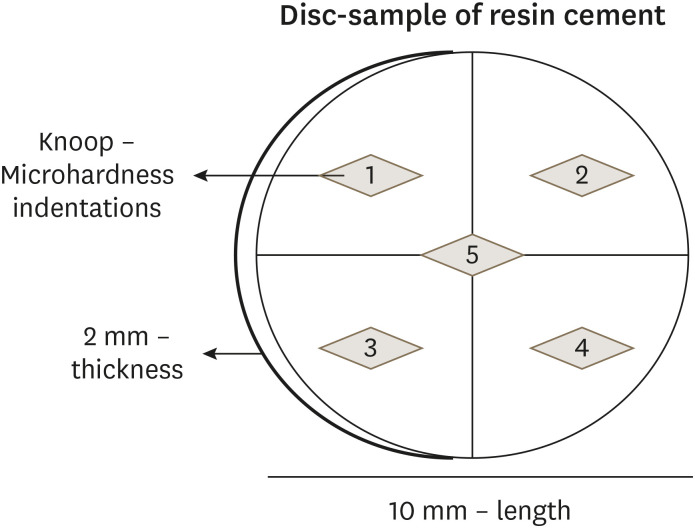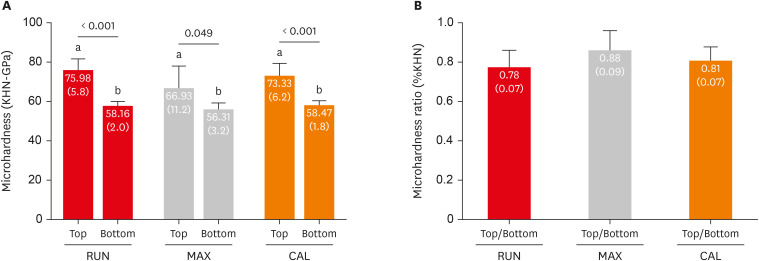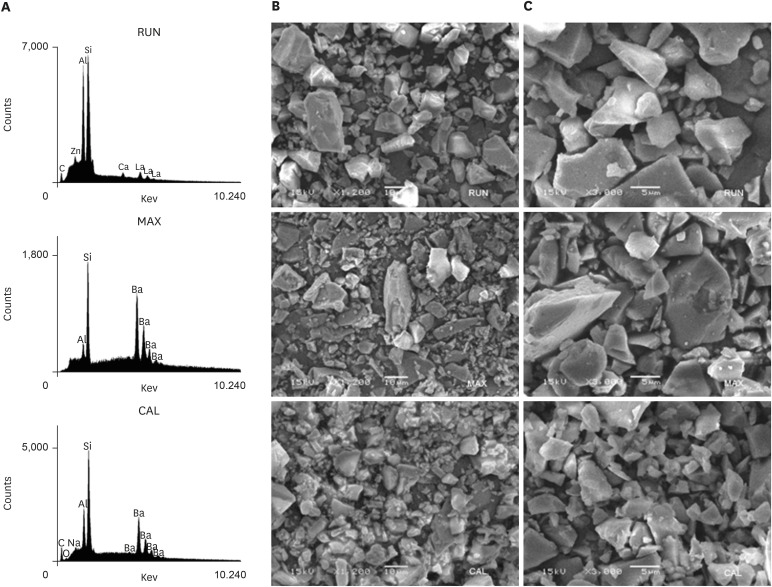Restor Dent Endod.
2022 Aug;47(3):e32. 10.5395/rde.2022.47.e32.
Influence of inorganic composition and filler particle morphology on the mechanical properties of selfadhesive resin cements
- Affiliations
-
- 1Department of Restorative Dentistry, Piracicaba Dental School, State University of Campinas, Piracicaba, SP, Brazil
- 2Department of Cariology, Operative Dentistry and Dental Public Health, Indiana University School of Dentistry, Indianapolis, IN, USA
- KMID: 2548136
- DOI: http://doi.org/10.5395/rde.2022.47.e32
Abstract
Objectives
This study aimed to evaluate the influence of inorganic composition and filler particle morphology on the mechanical properties of different self-adhesive resin cements (SARCs).
Materials and Methods
Three SARCs including RelyX Unicem-2 (RUN), Maxcem Elite (MAX), and Calibra Universal (CAL) were tested. Rectangular bar-shaped specimens were prepared for flexural strength (FS) and flexural modulus (FM) and determined by a 3-point bending test. The Knoop microhardness (KHN) and top/bottom microhardness ratio (%KHN) were conducted on the top and bottom faces of disc-shaped samples. Sorption (Wsp) and solubility (Wsl) were evaluated after 24 hours of water immersion. Filler morphology was analyzed by scanning electron microscopy and X-ray energy dispersive spectroscopy (EDS). FS, FM, %KHN, Wsp, Wsl, and EDS results were submitted to 1-way analysis of variance and Tukey’s post-hoc test, and KHN also to paired t-test (α = 0.05).
Results
SARC-CAL presented the highest FS value, and SARC-RUN presented the highest FM. SARC-MAX and RUN showed the lowest Wsp and Wsl values. KHN values decreased from top to bottom and the SARCs did not differ statistically. Also, all resin cements presented carbon, aluminum, and silica in their composition. SARC-MAX and RUN showed irregular and splintered particles while CAL presented small and regular size particles.
Conclusions
A higher mechanical strength can be achieved by a reduced spread in grit size and the filler morphology can influence the KHN, as well as photoinitiators in the composition. Wsp and Wsl can be correlated with ions diffusion of inorganic particles.
Figure
Reference
-
1. Madruga FC, Ogliari FA, Ramos TS, Bueno M, Moraes RR. Calcium hydroxide, pH-neutralization and formulation of model self-adhesive resin cements. Dent Mater. 2013; 29:413–418. PMID: 23398784.
Article2. Manso AP, Carvalho RM. Dental cements for luting and bonding restorations: self-adhesive resin cements. Dent Clin North Am. 2017; 61:821–834. PMID: 28886770.3. Miotti LL, Follak AC, Montagner AF, Pozzobon RT, da Silveira BL, Susin AH. Is conventional resin cement adhesive performance to dentin better than self-adhesive? A systematic review and meta-analysis of laboratory studies. Oper Dent. 2020; 45:484–495. PMID: 32101496.
Article4. Ferracane JL, Stansbury JW, Burke FJ. Self-adhesive resin cements - chemistry, properties and clinical considerations. J Oral Rehabil. 2011; 38:295–314. PMID: 21133983.
Article5. Kim KH, Ong JL, Okuno O. The effect of filler loading and morphology on the mechanical properties of contemporary composites. J Prosthet Dent. 2002; 87:642–649. PMID: 12131887.
Article6. Saskalauskaite E, Tam LE, McComb D. Flexural strength, elastic modulus, and pH profile of self-etch resin luting cements. J Prosthodont. 2008; 17:262–268. PMID: 18086139.7. Ramos MB, Pegoraro TA, Pegoraro LF, Carvalho RM. Effects of curing protocol and storage time on the micro-hardness of resin cements used to lute fiber-reinforced resin posts. J Appl Oral Sci. 2012; 20:556–562. PMID: 23138743.
Article8. Pedreira AP, Pegoraro LF, de Góes MF, Pegoraro TA, Carvalho RM. Microhardness of resin cements in the intraradicular environment: effects of water storage and softening treament. Dent Mater. 2009; 25:868–876. PMID: 19217152.
Article9. Vrochari AD, Eliades G, Hellwig E, Wrbas KT. Curing efficiency of four self-etching, self-adhesive resin cements. Dent Mater. 2009; 25:1104–1108. PMID: 19427029.
Article10. Alkhudhairy F, AlKheraif A, Naseem M, Khan R, Vohra F. Degree of conversion and depth of cure of Ivocerin containing photo-polymerized resin luting cement in comparison to conventional luting agents. Pak J Med Sci. 2018; 34:253–259. PMID: 29805389.
Article11. International Organization for Standardization. Technical Committee. ISO/TC 106/SC 1. Dentistry-polymer-based restorative materials (ISO 4049). 4th ed. Geneva: ISO;2009.12. Nakamura T, Wakabayashi K, Kinuta S, Nishida H, Miyamae M, Yatani H. Mechanical properties of new self-adhesive resin-based cement. J Prosthodont Res. 2010; 54:59–64. PMID: 19879828.
Article13. Velo MM, Nascimento TR, Scotti CK, Bombonatti JF, Furuse AY, Silva VD, Simões TA, Medeiros ES, Blaker JJ, Silikas N, Mondelli RF. Improved mechanical performance of self-adhesive resin cement filled with hybrid nanofibers-embedded with niobium pentoxide. Dent Mater. 2019; 35:e272–e285. PMID: 31519351.
Article14. Aguiar TR, André CB, Ambrosano GM, Giannini M. The effect of light exposure on water sorption and solubility of self-adhesive resin cements. Int Sch Res Notices. 2014; 2014:610452. PMID: 27379329.
Article15. Gomes de Araújo-Neto V, Sebold M, Fernandes de Castro E, Feitosa VP, Giannini M. Evaluation of physico-mechanical properties and filler particles characterization of conventional, bulk-fill, and bioactive resin-based composites. J Mech Behav Biomed Mater. 2021; 115:104288. PMID: 33383377.
Article16. Aguiar TR, Di Francescantonio M, Bedran-Russo AK, Giannini M. Inorganic composition and filler particles morphology of conventional and self-adhesive resin cements by SEM/EDX. Microsc Res Tech. 2012; 75:1348–1352. PMID: 22628243.
Article17. Gerth HU, Dammaschke T, Züchner H, Schäfer E. Chemical analysis and bonding reaction of RelyX Unicem and Bifix composites--a comparative study. Dent Mater. 2006; 22:934–941. PMID: 16364427.
Article18. Sabbagh J, Ryelandt L, Bachérius L, Biebuyck JJ, Vreven J, Lambrechts P, Leloup G. Characterization of the inorganic fraction of resin composites. J Oral Rehabil. 2004; 31:1090–1101. PMID: 15525388.
Article19. Pan Y, Xu X, Sun F, Meng X. Surface morphology and mechanical properties of conventional and self-adhesive resin cements after aqueous aging. J Appl Oral Sci. 2018; 27:e20170449. PMID: 30427472.
Article20. Zhou M, Drummond JL, Hanley L. Barium and strontium leaching from aged glass particle/resin matrix dental composites. Dent Mater. 2005; 21:145–155. PMID: 15681013.
Article21. Polydorou O, König A, Hellwig E, Kümmerer K. Long-term release of monomers from modern dental-composite materials. Eur J Oral Sci. 2009; 117:68–75. PMID: 19196321.
Article22. Salazar DC, Dennison J, Yaman P. Inorganic and prepolymerized filler analysis of four resin composites. Oper Dent. 2013; 38:E201–E209. PMID: 23713809.
Article23. Timmons S, Cobb D, Stanford C, Dawson D, Denehy J, Vargas M, Asmussen C, Wefel J. Post-operative sensitivity of bonded ceramic posterior inlays and onlays. In : Proceedings of 2004 IADR/AADR/CADR General Session (Honolulu, Hawaii); 2004 Mar 12; Honolulu, HI. Alexandria, VA: International Association for Dental Research;2004.24. Cobb D, Timmons S, Stanford C, Dawson D, Denehy J, Vargas M, Asmussen C, Wefel J. Clinical outcomes of ceramic inlays/onlays luted with two bonding systems. In : Proceedings of 2004 IADR/AADR/CADR General Session (Honolulu, Hawaii); 2004 Mar 12; Honolulu, HI. Alexandria, VA: International Association for Dental Research;2004.
- Full Text Links
- Actions
-
Cited
- CITED
-
- Close
- Share
- Similar articles
-
- Effects of a relined fiberglass post with conventional and self-adhesive resin cement
- Influence of 10-MDP concentration on the adhesion and physical properties of self-adhesive resin cements
- Evaluation of mechanical properties of several dual-cure resin cements by curing modes
- Simple methods to enhance bond strength of self-adhesive resin cements
- Effect of solution temperature on the mechanical properties of dual-cure resin cements





